
Page 52: of Marine Technology Magazine (September 2022)
Read this page in Pdf, Flash or Html5 edition of September 2022 Marine Technology Magazine
MTR 100
Sonardyne https://www.sonardyne.com/
Sonardyne works across acoustic, inertial, optical and so- environments using its SPRINT-Nav hybrid navigation in- nar systems to solve the challenges that users of the ocean strument. Sonardyne is also working with the University face, whether that’s increasing marine autonomous system of Southampton to develop new sea? oor imaging capabil- capability, interoperability and endurance or increasing ity for autonomous underwater vehicles (AUVs), through sustainability by reducing reliance on crewed platforms. the ‘BioCam’ development, as well as collaborating with
Sonardyne has recently entered the latest phase of a ? rst- Newcastle University and Thales on a UK Defence Science of-a-kind project with Shell Brasil, Petrobras and Brazil- and Technology Laboratory (Dstl) funded project to create ian research institute SENAI CIMATEC. The project is a new waveform for secure communications between un- focused on combining new, semi-permanent ocean bot- derwater naval assets. tom nodes that can acquire and then of? oad high resolu- Sonardyne has been working with Exeter-based USV in- tion seismic data to an autonomous underwater vehicle novator HydroSurv to develop rapid, seabed-to-shore data (AUV) platform, with the help of Sonardyne technologies, gathering capability for offshore wind operators. That including a variant of its high bandwidth optical commu- project, supported by Innovate UK, brought together in- nications, BlueComm. This will bring a step-change to 4D telligent sea? oor sea? oor and vessel-mounted instruments seismic data gathering in Brazil’s deepwater pre-salt re- with HydroSurv’s REAV 40, satellite communications and gion, making it more sustainable and reducing cost and cloud-based services; a combination demonstrated earlier environmental footprint. this year to the developers of the Valorous ? oating offshore
In the UK, Sonardyne has a strategic partnership with the wind farm, in the UK’s Celtic Sea.
University of Plymouth geared towards innovation within Lastly, Sonardyne is also working directly with partners, the UK’s growing marine robotics and autonomous sys- including submersible manufacturer MSubs, to advance tems sector. This is leveraging the university’s academic naval platform capabilities. This includes using Sonar- resources and research facilities with Sonardyne’s COTS dyne’s COTS navigation, communications and imaging acoustic and inertial navigation technologies and access to payloads, such as SPRINT-Nav X, on MSubs’ extra-large the Smart Sound Plymouth marine robotics proving area. uncrewed underwater vehicles (XLUUV), as well as its
Sonardyne’s COTS and new technologies are also being Vigilant forward-looking sonar, developed by sister com- developed in joint innovation projects with industry part- pany Wavefront Systems and manufactured and commer- ners. For example, we worked with SEA-KIT and the UK’s cialised by Sonardyne. Both technologies are helping to
Defence and Security Accelerator (DASA) to ensure robust extend endurance and provide naval forces with enhanced uncrewed surface vehicle (USV) navigation in challenging situational awareness across the underwater battlespace.
52 September/October 2022
MTR #7 (50-65).indd 52 10/3/2022 8:54:25 AM

 51
51

 53
53
